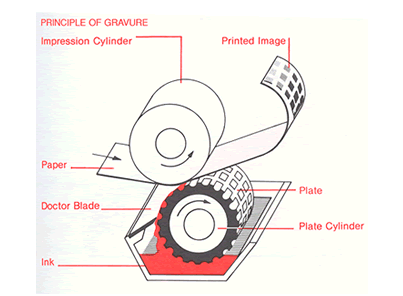|
![[In allestimento]](images/undercon.gif)
| | 
Rotogravure (Roto or Gravure for short) is a type of
process, where an engraved cylinder transfer the images by direct pressure onto
an impression rubber coatet roller on the material to be print.
In rotogravure can be used different kind of inks:
 | Solvent base |
 | Water Base |
After the printing the ink, which is a mixture of pigments and solvents,
needs to be "dryed" , the drying process evaporate the solvents which
is the liquid component of the ink so only the "solid" color remains
on the web.
The Rotogravure process is mostly used for food packaging and
publishing
The most recent technologies of "laser engraving" the printing
cilynders enhanced the printing resolution which reach a quality similar to
Offset printing quality.
Typical substates to be printed in gravure are:
 | Paper |
 | Carrdboard |
 | BOPP : Bi axially oriented polypropylen |
 | PET : Polyester |
 | BOPA: Bi axially oriented nylon |
 | PVC |
 | PE: polyetilene |
 | Aluminium foil |
Laminates which are structures composed by two or more layers of different
materials according to the final applications
In the food packaing most of printed materials need to be laminated with
another layer of film or aluminum foil in two, three or four layers structure
according to the final applicaton of the packaging and barriers properties
required.
The different purposes of the printing material arte mainly
 | Physical protection
- The food enclosed in the package may require protection from, among other
things, shock, vibration,
compression, temperature,
etc.
|
 | Barrier protection
- A barrier from oxygen, water vapor,
dust, etc., is often required. Permeation
is a critical factor in design. Some packages contain desiccants
or Oxygen absorbers
to help extend shelf life. Modified
atmospheres or
controlled atmospheres are also maintained in some food packages. Keeping
the contents clean, fresh, and safe for the intended shelf life
is a primary function.
|
 | Containment or
agglomeration - Small items are typically grouped together in one
package to allow efficient handling. Liquids, powders,
and granular materials
need containment.
|
 | Information
transmission - Packages and labels communicate how to use, transport, recycle, or dispose of the package or product. Some types of information are required
by governments.
|
 | Marketing - The
packaging and labels can be used by marketers
to encourage potential buyers to purchase the product. Package design has
been an important and constantly evolving phenomenon for several decades. Marketing
communications
and graphic design
are applied to the surface of the package and (in many cases) the point of sale
display.
|
 | Security -
Packaging can play an important role in reducing the security risks of shipment. Packages can be made with improved tamper resistance
to deter tampering and also can have tamper-evident
features to help indicate tampering. Packages can be engineered to help
reduce the risks of package pilferage:
Some package constructions are more resistant to pilferage and some have
pilfer indicating seals. Packages may include authentication
seals to help indicate that the package and contents are not counterfeit.
Packages also can include anti-theft devices, such as dye-packs, RFID
tags, or electronic
article surveillance
tags, that can be activated or detected by devices at exit points and
require specialized tools to deactivate. Using packaging in this way is a
means of retail loss
prevention.
|
 | Convenience -
Packages can have features which add convenience in distribution,
handling, stacking, display, sale, opening, reclosing, use, and reuse.
|
 | Portion
control - Single serving packaging has a precise amount of contents to
control usage. Bulk commodities (such as salt) can be divided into packages
that are a more suitable size for individual households. It also aids the
control of inventory: selling sealed one-liter-bottles of milk, rather than
having people bring their own bottles to fill themselves. (source
Wickipedia) |
Rotogravure typical machine configuration

|
